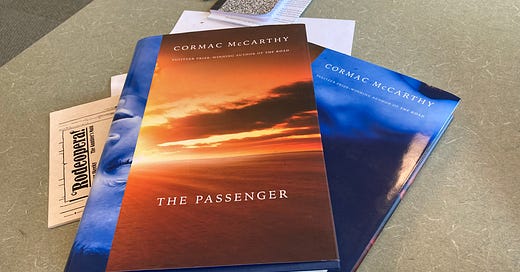Cormac McCarthy’s Style
Also: Editing Roald Dahl, selling the oldest copy of the Hebrew Bible, and more.
This weekend we had Michael Crews out to the house to talk about Cormac McCarthy to a bunch of people. I won’t steal Michael’s thunder—he is a McCarthy expert and visited the McCarthy archives to read the manuscripts of both The Passenger and Stella Maris before they were published—but he talked about McCarthy’s view of God and where the latest two novels fit in McCarthy’s oeuvre.
They are different from anything McCarthy’s has published—anti-novels, both of them—but chockfull of zippy, phantasmagorical sentences and characters. One character is called The Thalidomide Kid, and he is as mesmerizing as The Judge in Blood Meridian, if completely different as well (he has flippers for hands and is a kind of ringmaster). Michael remarked that whatever you make of these novels, they show a McCarthy at the height of his powers stylistically.
Both are also deeply pessimistic. In his excellent review at First Things, Jonathan Clarke remarks that the novels “contemplate the tragic limits of our understanding.” I don’t know if “tragic” is quite right. It suggests that such limits shouldn’t exist, and I don’t find any such suggestion in these novels—quite the opposite, in fact. Alicia’s genius, as Clarke points out, is isolating. In the novel, Alicia is not dangerous (though Michael suggested in his talk that she might be), but other intelligent, solitary characters in McCarthy’s novels are. The Judge is the obvious case in point.
Is the pessimism of the novels and the beauty of their sentences connected? Perhaps. Clarke writes that “McCarthy finds great beauty in complexity science” and that “Stella Maris asks us to believe that this beauty is both our consolation and possibly our undoing.” It’s not just the beauty of science that provides consolation in the novels, it is beauty in general—Alicia’s beauty, the beauty of nature, and the beauty of language. The Passenger ends with Bobby Western thinking of his death: “He knew that on the day of his death he would see her face and he could hope to carry that beauty into darkness with him, the last pagan on earth, singing softly upon his pallet in an unknown tongue.”
For McCarthy, beauty will not save you, and it certainly won’t save the world. The most we can hope for is a momentary stay against darkness like the one described above. This gives a weight—an urgency—to McCarthy’s sentences, but it can also empty them out. Is Bobby right to hope that he will carry the image of the beautiful Alicia with him “into the darkness,” or is he too weak (he calls himself a coward) or too unintelligent to image the alternative? In Stella Maris, his sister describes death by drowning—and it’s significant that Bobby’s comments above are made when he’s living by the sea—in less sentimental terms: “When you’ve finally given up your rat’s struggle and breathe in the water—scaldingly cold—you are going to experience pain beyond the merely agonizing . . . And it’s not going to go away. Because your lungs can never warm the water they’ve inhaled. I think we’re talking about an agony that is simply off the scale. No one’s ever said. And it’s forever. Your forever.”
In other news: Sidney Reilly was “an opportunist, a risk-taker, and a smooth-talking charm merchant (his bewildering web of love affairs and marriages warrants a book in their own right) with an instinct for being in the right place at the right time. Until he wasn’t.” A. E. Smith reviews Sidney Reilly: Master Spy.
Roald Dahl’s books have been edited to make them less “offensive”: “Edits have been made to descriptions of characters’ physical appearances. The word ‘fat’ has been cut from every new edition of relevant books, while the word ‘ugly’ has also been culled, the Daily Telegraph reported. Augustus Gloop in Charlie and the Chocolate Factory is now described as ‘enormous’. In The Twits, Mrs Twit is no longer ‘ugly and beastly’ but just ‘beastly’. Hundreds of changes were made to the original text – and some passages not written by Dahl have been added . . . In The Witches, a paragraph explaining that witches are bald beneath their wigs ends with the new line: ‘There are plenty of other reasons why women might wear wigs and there is certainly nothing wrong with that.’” Salman Rushdie called the edits “absurd.” In The Spectator, Sam Leith writes: “Roald Dahl was, in many respects, a horrible man. He was a narcissist, a bully, a liar, an anti-Semite, a tax-dodger, a faithless husband and – if his daughter’s account is to be believed – a cruel and thoughtless father. None of which has anything whatever to do, it scarcely needs saying, with the content of his books.”
The world’s oldest copy of the Hebrew scriptures is up for auction: “At more than 1,000 years old, the Codex Sassoon is the world’s earliest near-complete Hebrew Bible. Soon, it could also become the ‘most valuable historical document ever sold at auction,’ according to a statement from Sotheby’s. The auction house expects to sell it for between $30 and $50 million in May. Historians say a scribe wrote out the text on roughly 400 sheets of parchment in the late ninth or early tenth century. Eventually, the book landed at a synagogue in present-day Syria, which was then destroyed around the 13th or 14th century.”
A Jeff Koons balloon sculpture is accidently shattered in Miami: “The shattered sculpture, according to Boero, was valued at $24,000 a year ago. But its price went up as other iterations of the balloon dog sculpture sold out.”
Montessori myths: “It is a measure of Montessori’s later self-mythologizing that she claimed to be Italy’s first female doctor, whereas she was simply among the first. Nor was it the case, says De Stefano, coming daringly close to calling the Dottoressa a fibber, that her career as a medical student at the University of Rome was impeded by the pope, the Freemasons, and the academic establishment—‘all things that on close examination turn out to be invented.’ In fact, the evidence that De Stefano has uncovered suggests that Montessori’s professors, who were as progressive and feminist as the times allowed, went out of their way to help.”
The reviews are in, and the critics hate that Winnie-the-Pooh horror film: “Written and directed by Rhys Frake-Waterfield (The Area 51 Incident, Firenado), Blood and Honey follows a deformed Pooh (Craig David Dowsett) and Piglet (Chris Cordell) as they descend into a murderous rampage after Christopher Robin (Nikolai Leon) leaves them behind to go to college. Forced to fend for themselves, the creatures of the Hundred Acre Wood begin eating each other (R.I.P. Eeyore) and turn feral.”
HarperCollins employees to return to work on Tuesday after union ratifies new contract: “According to Local 2110 of the UAW, the union that represents unionized HarperCollins employees, the contract ‘achieves improved compensation and benefits, including higher minimums, guaranteed annual increases for everyone rated above “unsatisfactory,” two hours of overtime without approval for lowest paid employees, improved union rights with release time during work hours, paid time to participate in the joint labor-management committee and company’s diversity initiatives, improved paid time off, and ability to continue to work remotely until July 1.’ In terms of minimum salaries, the lowest salary, $47,500, will increase to $48,500 in January 2024 and go up to $50,000 in January 2025. More details of the agreement can be found here.”
Who is Costin Alamariu and how seriously should we take Bronze Age Mindset? Jack Butler explains: “While he’s tried to maintain an air of mystery, multiple sources have identified BAP as Costin Vlad Alamariu, a Yale University political science PhD of Romanian extraction. (Alamariu has never publicly confirmed or denied that he is BAP, and he did not respond to The Daily Beast’s requests for clarification.) Writing under his own name, Alamariu occasionally contributed to conservative publications like the Daily Caller (‘Mass Immigration Will Make The U.S. More Like Latin America’) a book review for New Criterion; and a couple of pieces for the paleoconservative site, Taki’s Magazine. But it wasn’t until he began writing as Bronze Age Pervert that he made his mark. In 2018 he self-published Bronze Age Mindset (BAM), a book-length ‘exhortation’ purporting to ‘draw back the curtain on this Iron Prison and show you where it is you really live.’ . . . By October 2019, the book ranked as high as No. 3 on Amazon’s subcategory ‘Ancient Greek History’ and Politico reported BAM was clandestinely circulating among young male staffers in the Trump White House. All this without so much as a book agent, let alone a publishing house. (In BAM, Alamariu acknowledges that ‘normies’ will find his ideas ‘crazy,’ and thus advises his fans to deny having read him if asked, making the actual extent of his popularity difficult to measure.)”
Mike Watson reviews Robert Kagan’s The Ghost at the Feast: “The second part of a trilogy about American foreign policy, the book covers 1900-1941, the period when the United States became the strongest of the great powers and missed its opportunity to create a durable peace.”
Stephen Kotkin reviews Alexander Mikaberidze’s biography of Mikhail Kutuzov. It is, Kotkin writes, one of “the best biographies of Russian historical figures, comparable in readability to Simon Sebag Montefiore’s Potemkin and in terms of exactitude to Paul Buskovitch’s Peter the Great.”
Is this painting a Raphael? “Anthony Ayers had a hunch that he’d found a masterpiece. While vacationing in the English countryside in 1995, Mr. Ayers spotted a dusty, wood-panel painting tucked behind an armoire in an antique shop. It depicts Mary holding an infant Jesus in her lap as her older cousin Elizabeth and a toddler John the Baptist look on lovingly; the backdrop features an oak tree with a goldfinch, an ancient symbol foreshadowing the Crucifixion. The shopkeeper suggested that the painting could be from the Renaissance. Mr. Ayers wasn’t an art historian—he was an amateur artist and cabinet maker in the Chicago area—but he was intrigued enough to ask a few friends to pool their funds and buy the painting for roughly $30,000. ‘Tony just knew it was something,’ said his wife Dawn Turco, who was with him when he discovered it. ‘He could not get it out of his head.’ Mr. Ayers soon came to believe that what he’d found was actually a Raphael.”






In terms of responses to the Bronze Age Pundit, Butler's is OK but I think there are better ones (1, 2). At any rate, evaluating and critiquing BAPist ideas is likely to be more productive in the long run than simply issuing angry denunciations (3).
1. https://claremontreviewofbooks.com/are-the-kids-altright/
2. https://www.tabletmag.com/sections/arts-letters/articles/bronze-age-pervert-dissertation-leo-strauss
3. https://twitter.com/PatrickDeneen/status/1627387391588671489